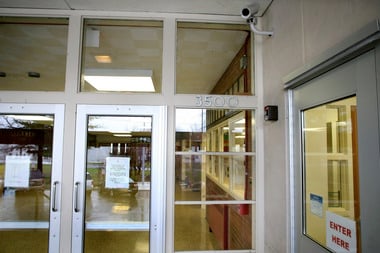If you’re working with a school on a renovation project that includes bullet resistant components, then April is the month to solidify your quote and timeline. But that process can get derailed by sticker shock. Most of your clients will only know about bullet resistant materials from movies and television; they may significantly over estimate what the materials can do and under estimate what it will cost to do it.
For example, following the December 2012 attack on Sandy Hook Elementary School, Total Security Solutions sales manager Bob George found himself constantly on the phone with people interested in bullet proof security for their schools.
“We got inundated with calls,” Bob explains, “from parents, principals, superintendents, grandparents–and everyone was saying ‘We want to do the whole school!’ But that just isn’t realistic; you’re talking half a million dollars to do a whole school.”
Not only is a project like that beyond what a school can afford, it’s also well beyond what a school needs.
Tailoring a Bulletproof System
According to Bob George, designing any bullet proof retrofit is largely about “catering to what’s already there” in terms of aesthetics, structure, and use patterns. In contrast to retail applications, school operations and building practices are generally working with you, not against you, when it comes to adding bullet proof security.
In a retail retrofit you’ll often find that walls and counters need significant reinforcement in order to support the extra weight of bullet resistant glass and components. “Schools are almost always block wall construction,” Bob points out. Block walls offer significant bullet resistance on their own; they’re one of the few building materials that can truly be said to be “bullet proof,” not just bullet resistant. “You also have good anchorage to work from, to support heavy bullet resistant doors and windows. Schools are just built heavier than the traditional bullet proof barrier buyer.” As an architect, all of this works to your advantage.
School use patterns and visitor policies also lend themselves to enhanced security. Because schools already funnel students and visitors through a single entryway, it’s relatively easy to contain costs in a bullet proof school renovation by focusing on converting that single entryway into a controlled checkpoint. Total Security Solutions vice president Jim Richards favors a tried-and-true “reinforced vestibule” solution, which increases security without straining budgets.
“What we’ve seen a lot of in school renovations and new construction is reinforcing the front vestibule: Replace the existing widows with bullet resistant glass, add a transaction window for the receptionist, and secure the interior bullet resistant doors with electric latches controlled by the receptionist. Once you have the ability to lock that vestibule down, no one enters the building without authorization.”
Relatively small structural changes can transform a vulnerable school to a bullet proof fortress.
Making a Bullet Resistant Retrofit Run Smoothly
Small discrepancies in plans or specifications–the sorts of things that can be easily sorted out on site in a conventional construction project–can badly complicate a bullet proof installation.
For example, while architects have many options when it comes to conventional door and window frames, UL-rated bullet resistant components are rigorously tested for a precise set of dimensions and configurations. In order to make it as easy as possible for architects to stay within the constraints of these rated components, Total Security Solutions has prepared detailed reference PDFs and ready-to-use CAD elements.
“I like to talk to architects up front,” Bob notes. “Getting them solid information early on really makes these projects run smoothly.”
Next Steps
- Get information about School Security in our Resource Center
- Read additional blogs about School Security
- Download our School Security Checklist
- Contact us if you need additional questions about school security answered


